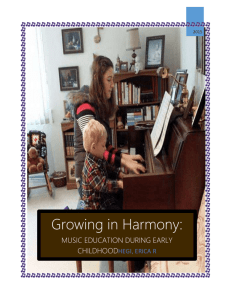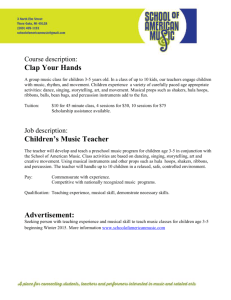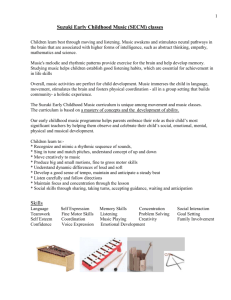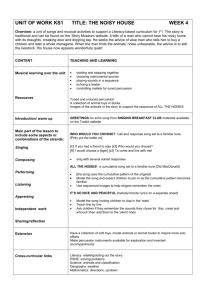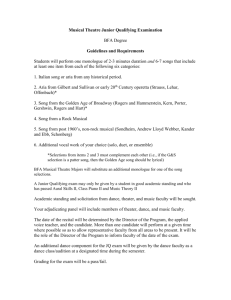Listening and Responding
advertisement
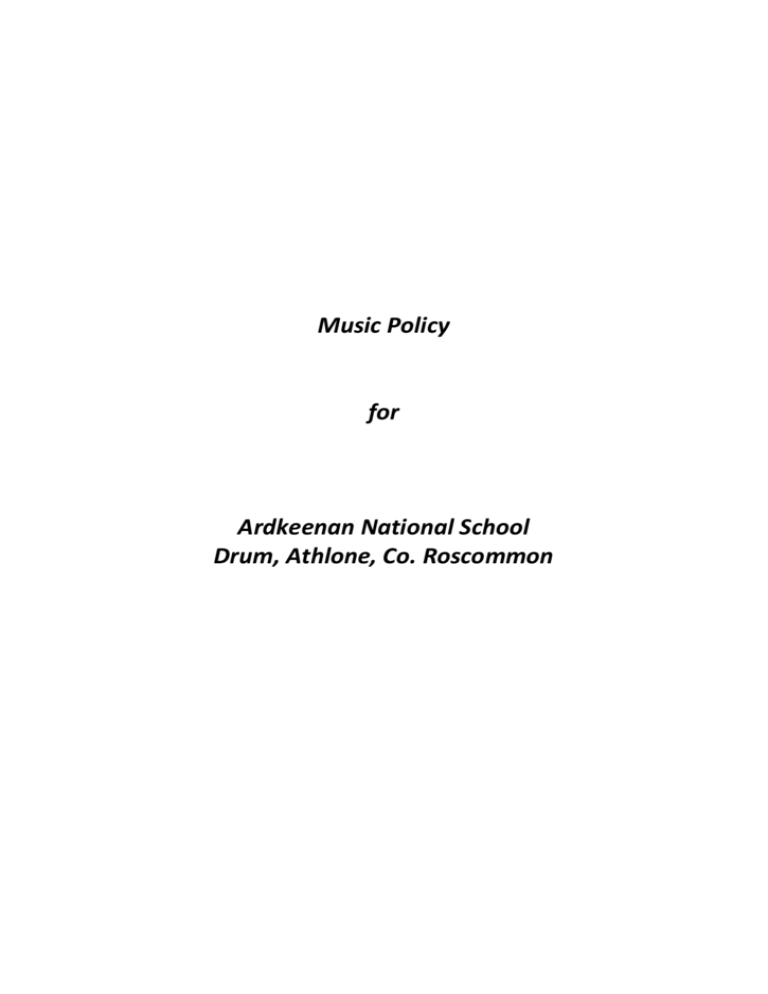
Music Policy for Ardkeenan National School Drum, Athlone, Co. Roscommon Ardkeenan N.S. Music Policy Introduction: This plan was formulated by all the teaching staff of Ardkeenan N.S. with reference to The Primary Curriculum Guidelines for Music. We see music as offering lifelong opportunities for the development of imagination, sensitivity, inventiveness, risk-taking and enjoyment. The curriculum emphasises active responses and music making at all levels. Rationale: We are drawing up this plan to build on good practice and to help teachers plan. Vision: Our vision for the pupils of Ardkeenan N.S. is that through music they may experience the joy and satisfaction of shared experiences, while at the same time developing and fostering a deep sense of well-being, creativity and self-esteem. Aims: The aims of the music curriculum are: To enable the child to enjoy and understand music and to appreciate it critically. To develop the child’s openness to, awareness of and response to a wide range of musical genres, including Irish music. To develop the child’s capacity to express ideas, feelings and experiences through music as an individual and in collaboration with others. To enable the child to develop his/her musical potential and to experience the excitement and satisfaction of being actively engaged in musical creativity. To nurture the child’s self-esteem and self-confidence through participation in musical performance. To foster higher order thinking and lifelong learning through the acquisition of musical knowledge, skills, concepts and values. To enhance the quality of the child’s life through aesthetic musical experience. Content of Plan: The key messages are: Music is for all teachers and for all pupils. The three strands of the Music curriculum – listening and responding, performing and composing are equally important. Active enjoyable participation is fundamental to the music curriculum. Music enhances the child’s life. Musical Concepts: (a) Pulse: - throb, steady beat, strong or weak, grouped, e.g. in 3’s or 4’s. (b) Duration: -long/short, patterns, rhythm, silences. (c) Tempo: -fast/slow. (d) Pitch: - high/low, imitate melodies, perceive the shape of a melody on a stave, movement by steps or by leaps. (e) Dynamics: - loud/soft, getting louder, getting softer. (f) Structure:- same/different, identify a contrasting or repeated section. (g) Timbre: - tone colour – explore and differentiate between different sounds and instruments. (h) Texture: - one sound/ several sounds from graphic or when listening. (i) Style;- listen and respond to music in a wide range of styles. Strands and strand Units: Listening and Responding Exploring sounds Environmental. Vocal. Body percussion. Instrumental. Listening and responding to music. Performing Song singing. unison singing simple part singing. Literacy rhythm pitch rhythm and pitch Playing instruments. Composing Improvising and creating. Talking about and recording compositions. The three strands and their strand units should be spread equally throughout the year. They should be regarded as highly inter-related i.e. understanding in one strand is dependent upon and supportive of understanding in another and an aspect of each strand may feature within a single lesson. Approaches and Methodologies: All teachers and children are actively engaged in music education in Ardkeenan N.S. The approaches and methodologies used foster active, enjoyable participation in the new music curriculum. There is a positive musical environment that encourages and values sharing of ideas and skills and resources among teachers and pupils alike. We participate in listening and singing in class, performing at school concert and celebratory events throughout the school year and in the local community ,playing tin whistle, choir for Communion, Confirmation and First Confession in Drum Church, playing percussion instruments and improvising activities. Strand – Listening and Responding; Children in our school are provided opportunities to listen and respond to music by experiencing a wide range of musical styles, traditions and cultures. Teachers provide opportunities for active listening and responding by questioning, prompting, suggesting, listening to short examples. Below is a whole school two year plan for the strand listening and responding. Year 1 Year 2 Year 1 Year 2 Sept Morning Edvard Greig Oct Pastoral SymphonyKurt Mazur Nov Ride of the ValkyriesWagner Dec Nativity songs Radetsky March Strauss Eine Kleine Nacht MusikMozart Mar Irish Music for Seachtain na Gaeilge African musicMarket day Irish Music for Seachtain na Gaeilge African musicMarket Day MoonlightBeethoven Nativity songs Apr Chorus of the Hebrew Slaves-Verdi May The Flower DuetDelibes June Here comes the sunNina Simone Nessun DormaPucci The four seasonssummerVivaldi Jazz Feb Blue DanubeJohann Strauss BoleroRavel Jan The four seasonsWinterVivaldi Rhapsody in Blue Gershwin Listening Materials: A broad range of listening materials are provided i.e. C.D., downloads from itunes Tuned and untuned percussion instruments. Environmental objects, e.g. assortments of metals, wood, fibres. Instruments of children in the class. Melodic instruments – tin whistles, piano, guitar. Instruments e.g. keyboard, tin whistle, Performance of musicians visiting the school Carol Behan (traditional) In selecting recorded music, a balance is maintained between music from Ireland and other countries, choral and instrumental, music for different occasions and purposes. Where possible music listened to is selected to link with whole school events eg. Seachtain na Gaeilge, celebrating seasons, Christmas etc. Strand– Performing; In the performing strand, the following are emphasised: Active enjoyable participation. Development of skills, understanding and knowledge. Fostering of children’s attitudes and interests. Development of skills, understanding and knowledge. Fostering of children’s attitudes and interests. Development of creativity. Song – Singing; Because the voice is everyone’s first instrument, it forms the key to access to music education in the classroom. Song singing is seen by our teachers as an ideal way of engaging large groups in enjoyable and fulfilling music making. Our teachers are aware that the range of notes of a song should be within the range of children’s voices. Some of our teachers teach a song by ear i.e. using their own voice, others use a melodic instrument. Teachers may also use a recording to teach songs. Opportunities are also provided for children to perform for an audience, in their own class, for other classes, for parents at the annual Christmas Concert and for Family Services in St. Brigid’s Church. All the children are given the opportunity to use the percussion and melodic instruments which are available in our school. Selecting a Song: The following criteria will be kept in mind; (a) appeal to teachers and children. (b) Genre – part of a selection of styles. (c) Suitability of words – age appropriate. (d) Range of notes – suited to the children’s voices. In choosing a song in Irish, teachers are sensitive to the difficulties a class may encounter with unfamiliar words. Preparatory work might be undertaken as part of the Irish lesson. Procedures for teaching a song: When introducing a song the teacher may choose one of the following approaches: Linking the song with a story or poem. Integrating the song with another curriculum area. Use a suitable picture to set a scene. Present the song with little or no discussion – let the song speak for itself. Whether the teacher sings or plays from a recording he/she should: Give a comfortable starting note with a pitched instrument. Look at the children and communicate with them. Give them something specific to listen for to help their concentration. Sing/play the whole song through once, thereafter, work on first verse only and chorus if applicable, concentrating on words, beat, rhythm, melody, diction, style and expression, usually in that order. Discuss briefly the theme or message of the song. Playing Instruments Pupils from Infants to 6th Class learn to play the tin whistle with Ms. Carrol Behan. They perform the pieces they have learnt to parents at our Seisiún Gaeilge and/or special events each year. Pupils also get opportunities to play percussion instruments as part of their classroom music programme. Percussion instruments may also be used to accompany songs at the Christmas Concert. Strand– Composing: Children are encouraged to improvise, discuss, evaluate and record music as part of the Composing strand. Opportunities are provided to improvise e.g. to accompany a rhyme, song, poem or story; to explore the musical concepts/elements; to experiment with sound; to portray a character, mood or setting; to illustrate events; to convey an abstract concept; to explore melody. Children are given the opportunities to compose/improvise using vocal sounds, body sounds, instruments and environmental sounds. Children are given opportunities to contribute to the setting of ground rules for creative music activity when organising composing activities. These may include Starting and stopping signals. The handling of instruments. Sound levels. Time spent on each activity. Movement around the classroom. Assessment: The assessment tools that our teachers use include; teacher observation and teacher designed tasks and tests. Teacher’s observations feed directly back into the teaching and learning process, emphasising areas of weakness or strength in the children’s achievement. In looking at the children’s work in each of the three strands, the teacher will also discern the development of musical elements as they emerge. Refer to; Listening and responding p. 125. Performing p. 126. Composing p. 127 of Teacher Guidelines. Children with different needs: Our teachers adapt and modify activities so that all children can participate meaningfully in classroom music. This includes varying the pace, content, language and methodologies to try to ensure learning and success for all children. Where possible, children who have difficulty will have help from a teacher or peer. Where a teacher recognises that a child displays a particular ability in Music, this will be communicated to the parents, so that the child may have opportunity to take out of school music lessons, circumstances permitting. We recognise that some children in our school learn musical instruments and teachers will encourage such children to play for their classmates, so that the other children will have opportunities to listen and respond to live music. Equality of Participation and Access All the children in our school will participate in all aspects of the Music curriculum. Boys and girls are provided with equal opportunities. Organisational Planning Timetable At the request of parents and approved by the Board of Management Ms.Carol Behan teaches tin whistle to children from Infants – 6th class every week for twenty minutes. These lessons take in children’s own classrooms once a week. Including tin whistle lessons,all classes will have a minimum of one hour per week of Music. This time allocation may be broken down at the discretion of the individual teacher. We recognise that in the junior classes, the time allotted will be of shorter duration on a more frequent basis, while senior classes may use longer time spans. We include block times for music at particular times of the year- Christmas Concert, Seisiún gaeilge during Seachtain na Gaeilge. Teachers should ensure that pupils attending support teaching are included for as much of the Music programme as possible. Main Resources: Music from internet Keyboard. C.D.Player – each class. Drum kit Chime Bars. Percussion Instruments. (box with a selection) A variety of cds, for listening and responding. Books- The Right Note, Upbeat, Song books, Christmas Musical Nativity plays. Novelty plays with CDs Health and Safety; When planning for music, consideration is given to the following; Hidden dangers if children are moving about the classroom. Storage facilities. Access to, and transport of, equipment/instruments. Amount of space for children to sit or stand when doing coral or instrumental work. Appropriate volume levels when using audio equipment and instructions. Individual Teacher’s Planning and Reporting: Teachers refer to the whole school plan and the curriculum documents for music to provide information and guidance for their long and short term planning. They plan using the strands and strand units, and on occasions, a thematic approach. The Cuntal Míosúil plays a part in reviewing and developing the whole school plan and individual planning. All teachers use the Right Note music scheme in the school which forms the basis of Long-term planning objectives. Music objectives are rotated on a year 1/ year 2 basis to facilitate multi-grade teaching. Parental Involvement; Parents are asked to give support to their children’s music activities by encouraging active listening, discussing attitudes towards and taste in music, allowing time and space to practise on the tin whistle and by encouraging positive attitudes to music in general and to school based activities in particular. Parents with musical expertise work with the children eg. for our annual Christmas concert, special celbrations etc. Success Criteria: This plan is intended to support and assist the learning and teaching of music in our school. We will know that the plan has achieved its aims when Children have a positive attitude and appreciation of music. Children have an interest in expression through music. Children engage in listening and responding, performing and composing music. Children have explored sound, including vocal sound, body percussion, instruments and environmental sounds. Children have listened and responded to music from a wide range of genres and cultures in a variety of ways. Children sing songs appropriate to their voice range, from a wide variety of genres and cultures. Children experience a variety of recording music, which may include graphic, pictorial and traditional music notation. Children improvise and create music using a variety of sound sources. Children talk about, evaluate and on occasions record their work. Implementation; The plan will be implemented and developed by the teachers and supported by the Board of Management. Review; This plan will be reviewed on a regular basis to ensure optimum implementation of the music curriculum in the school. Ratified 2007 Reviewed 2009 _______________________________________ next review 2011

